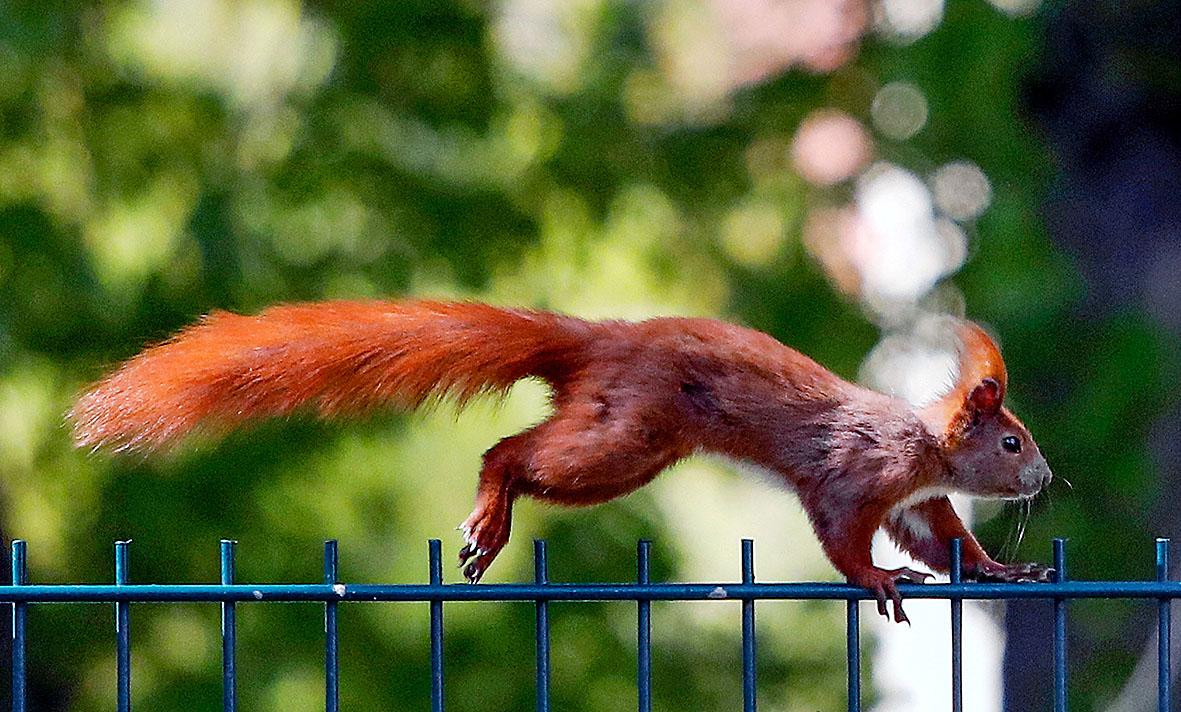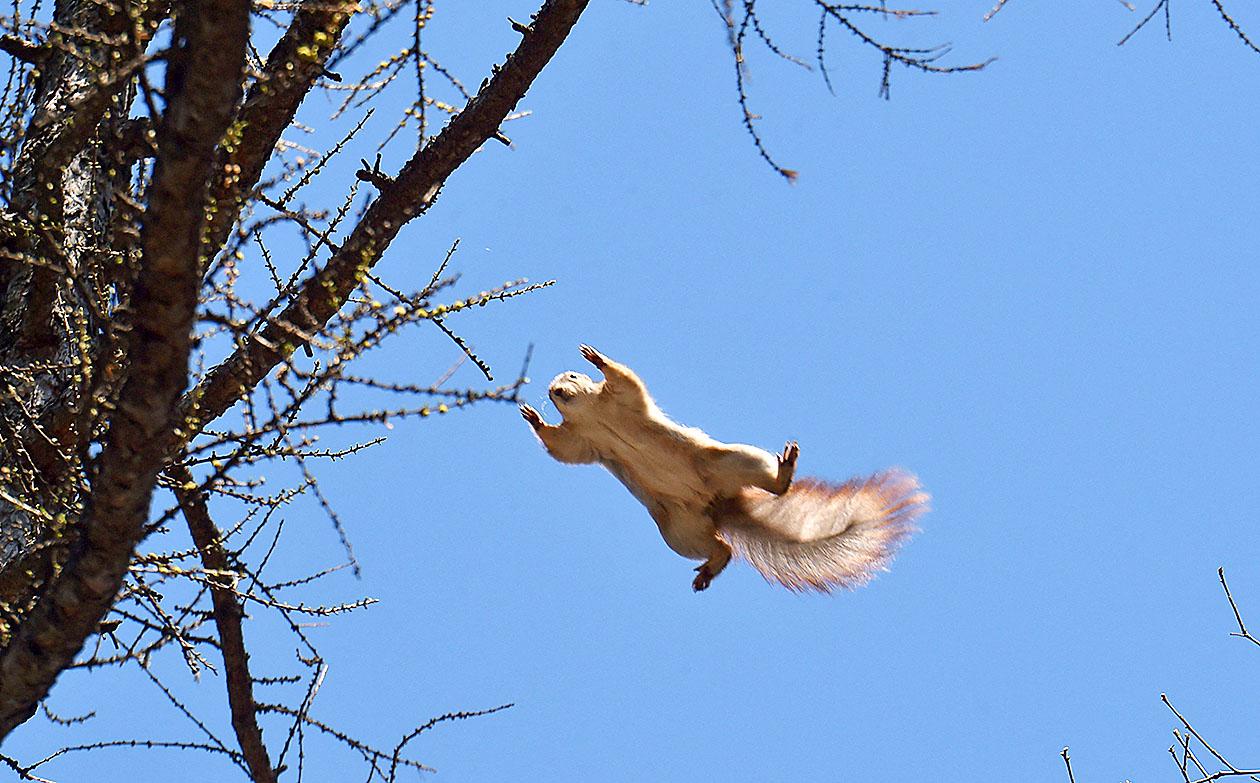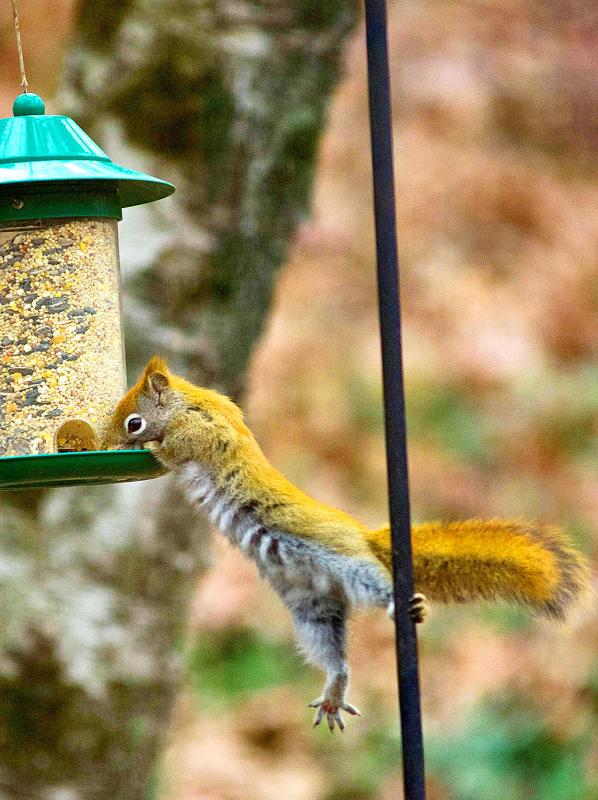Squirrels’ acrobatic leaps across treetops depend on complex split-second calculations and inventive “parkour” maneuvers to stick tricky landings, a new study in the journal Science said Thursday.
Scientists at UC Berkeley designed obstacle courses to better understand how the rodents gauge and adjust their movements on the fly, as they dart away from predators and avoid potentially fatal falls.
The hope is that the research could one day help to build more agile robots with better decision-making skills.

Photo: AFP
“Squirrels have a combination of traits that make them very interesting: one being their acrobatic nature, their biomechanics and their powerful muscles that they can use to leap many times their body length,” lead author Nathan Hunt said.
“The other is their cognitive capabilities, they have great memories, they’re highly creative animals, and they’re really good at problem solving.”
The team used peanuts to lure wild fox squirrels on the edge of campus to their experiments.

Photo: AFP
Perches were set up to simulate tree branches, forcing the squirrels to jump gaps of varying distances in order to receive their treats. The scientists were keen to learn how the animals would negotiate a critical trade-off: Moving towards the end of a perch reduced leaping distance, but compromised stability and jumping force as the launch platform became more wobbly.
It turned out the squirrels preferred to launch from the base of the perch, particularly when the branches were bendier. In fact, the bendiness of the branch was six times more critical than the gap distance in their decision making.
Throughout the experiments, none of the squirrels ever fell, because they used a variety of strategies — and their sharp claws — to recover from imperfect landings.

Photo: AFP
If they jumped too far, they would swing over the target perch and perform a roll around it to stick the landing.
If they jumped short, they swung underneath the perch before pulling themselves up.
But the most surprising innovation came when the squirrels didn’t aim for the target branch directly at all, instead bouncing off an adjacent wall to make the most challenging leaps, akin to parkour.
When squirrels are chased by hawks, their escapes come down to a matter of centimeters, which is probably why they evolved to become so nimble, said Hunt.
While the research might one day further the field of robotics, it’s also something people can appreciate when they see squirrels in parks or in their gardens, said Hunt.
“It’s a fun thing to communicate this research because people watch squirrels in their backyard all the time. Actually, as I just sit in my backyard and watch them, I come up with other ideas for experiments that I’d like to do.”

US President Donald Trump may have hoped for an impromptu talk with his old friend Kim Jong-un during a recent trip to Asia, but analysts say the increasingly emboldened North Korean despot had few good reasons to join the photo-op. Trump sent repeated overtures to Kim during his barnstorming tour of Asia, saying he was “100 percent” open to a meeting and even bucking decades of US policy by conceding that North Korea was “sort of a nuclear power.” But Pyongyang kept mum on the invitation, instead firing off missiles and sending its foreign minister to Russia and Belarus, with whom it

When Taiwan was battered by storms this summer, the only crumb of comfort I could take was knowing that some advice I’d drafted several weeks earlier had been correct. Regarding the Southern Cross-Island Highway (南橫公路), a spectacular high-elevation route connecting Taiwan’s southwest with the country’s southeast, I’d written: “The precarious existence of this road cannot be overstated; those hoping to drive or ride all the way across should have a backup plan.” As this article was going to press, the middle section of the highway, between Meishankou (梅山口) in Kaohsiung and Siangyang (向陽) in Taitung County, was still closed to outsiders

Many people noticed the flood of pro-China propaganda across a number of venues in recent weeks that looks like a coordinated assault on US Taiwan policy. It does look like an effort intended to influence the US before the meeting between US President Donald Trump and Chinese dictator Xi Jinping (習近平) over the weekend. Jennifer Kavanagh’s piece in the New York Times in September appears to be the opening strike of the current campaign. She followed up last week in the Lowy Interpreter, blaming the US for causing the PRC to escalate in the Philippines and Taiwan, saying that as

The Chinese Communist Party (CCP) has a dystopian, radical and dangerous conception of itself. Few are aware of this very fundamental difference between how they view power and how the rest of the world does. Even those of us who have lived in China sometimes fall back into the trap of viewing it through the lens of the power relationships common throughout the rest of the world, instead of understanding the CCP as it conceives of itself. Broadly speaking, the concepts of the people, race, culture, civilization, nation, government and religion are separate, though often overlapping and intertwined. A government